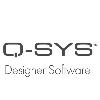New features regarding Network Video Endpoint and Reflect Enterprise Manager
Support for Q-SYS NV-21-HU Network Video Endpoint
- Introducing the next evolution for native Q-SYS video distribution, now supported in your Q-SYS designs.
- The NV-21-HU is a software-configurable endpoint offering a comprehensive single-cable solution for video distribution, AV bridging, and device charging via USB-C.
Q-SYS Video
- NV-32-H Core Mode Streaming feature license enables simultaneous functionality on the NV-32-H (Core Capable), offering Core processing and network video encoding/decoding, streamlining installations while lowering product and installation costs.
- Automatically frame near-end subjects– NC Series cameras can now automatically frame all people detected in the field-of-view, further enhancing meeting equity by ensuring that the far-end always sees a properly framed camera shot.
- Additional CEC Controls for HDMI display devices: Adds CEC-enabled control over Power, Input Select, Volume control and custom CEC command support for HDMI devices connected to an NV Series encoder/decoder.
Scale up your Core 610 Capabilities
- Core 610 Scaling License increases processing power to enable additional network channels, Media/WAN streaming channels, AEC channels and Q-SYS NM Series microphone capacity.
- Integrate up to 256 x 256 Dante network channels with new Software-based Dante license tier for the Core 610.
Q-SYS Reflect Enterprise Manager
- Extended API for deeper integration with third-party monitoring tools: All information on the Assets page is available via API along with Audit Log information, which includes information related to adding/removing users and permission levels (allowing for unauthorized use monitoring within their own toolset.)
- Receive Alerts and Notifications to your messaging tool of choice: Webhook based notifications streamline communications for support staff. Includes support for Microsoft Teams, Slack, ServiceNow and more.
Other Platform Enhancements
Software-based Dante optimized for 1 ms latency: Easier integration into mixed-protocol environments, providing parity with other audio over IP transports.


